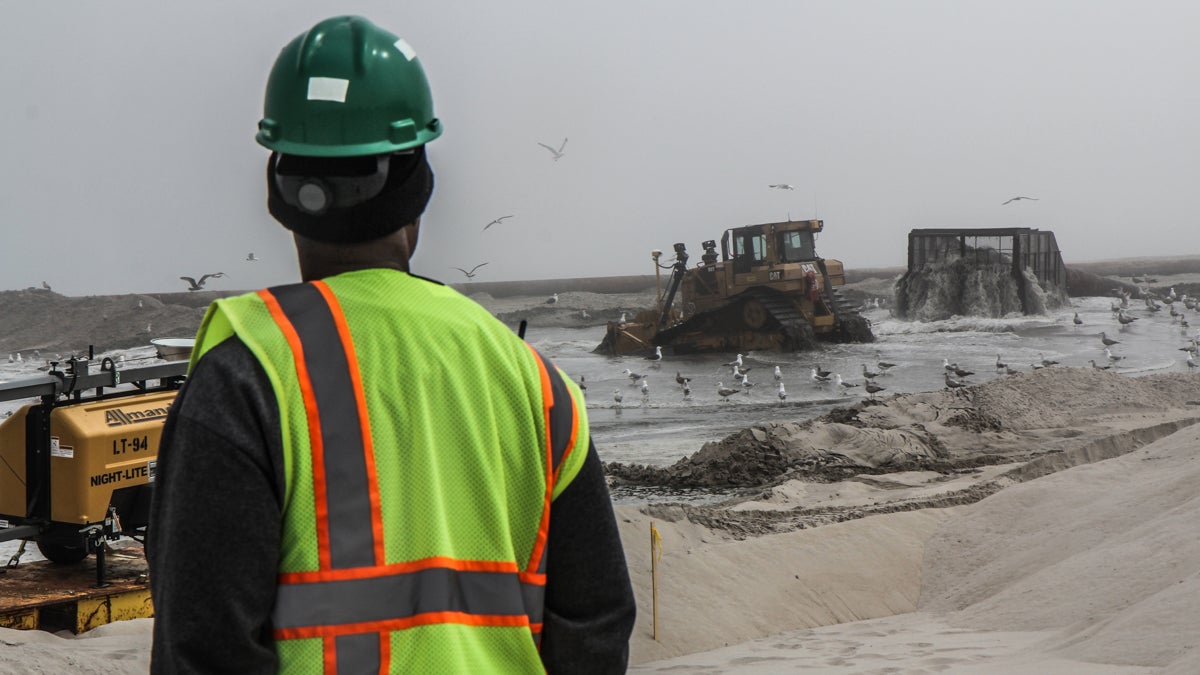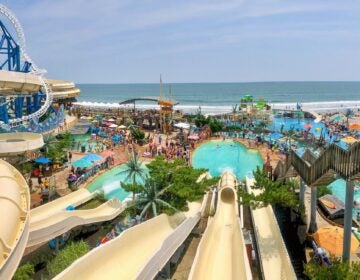The end of the Shore as we know it
The Jersey Shore is in danger, but instead of forcing it to adapt to what we want it to be and what we remember, we should adapt to what it will eventually become.

Beach replenishment efforts from May 2015 are shown in the borough of Ship Bottom in Ocean County. (Kimberly Paynter/WHYY, file)
Memorial Day is one week away — the official start of the season at the Jersey Shore.
Roads on the islands are obstacle courses of orange cones. Bridges are under construction. Some, like the Townsends Inlet Bridge are closed until further notice. On trash day, curbs are littered with mattresses, rusted bicycles, and broken boogie boards, casualties of previous seasons. The road into Sea Isle is being raised. Houses are being raised too. Large pipes are pumping sand onto beaches up and down the coast. Contractors and workers are putting in overtime in an effort to put the final touches on beachfront mansions before the owners come down.
All of this excessive time, money, and effort spent so we can spend another summer down the Shore and pretend that it will be here, like it is now, for generations to come; however, the truth is, evident with every passing nor’easter and hurricane, that these barrier islands are changing, as they always have. And instead of forcing the Shore to adapt to what we want it to be and what we remember, we should adapt to what the Shore will eventually become.
Due to global warming, sea level rise, storms, and beach erosion, we know our beloved Shore is in danger and that we must take drastic measures to save it. Of course the best solution would be to stop global warming; however, with the current political climate this seems unlikely, even as scientists continue to paint dire scenarios.
According to a March 2016 report published in Nature Climate Change, cited by Craig McCarthy on NJ.com, 827,499 New Jersey residents will have to relocate by 2100 due to rising sea levels. And even though this seems like a long way off, the evidence of its unwelcome reality is in the street at every full-moon high tide.
Option No. 1: More sand
So far there are two different ideas for how to deal with what remains of the Jersey Shore. The first is to build, pump, raise, and pray — versions of which have been done since the first beach groin projects in the wake of strong storms between 1915 and 1921. Currently, according to the New Jersey Department of Environmental Projection, there are “hurricane and storm damage reduction” projects in the works from Sandy Hook to Cape May. These projects include beach replenishment in popular Shore towns like Ventor, Margate, Ocean City, and Avalon.
Wayne Perry from the Associated Press wrote in 2012: “From 1986 to 2011, nearly $700 million was spent placing 80 million cubic yards of sand on about 55 percent of the New Jersey coast. Over that time, the average beach had gained 4 feet of width, according to the Coastal Research Center.”
Controversy surrounds many of these projects, not only because they use taxpayer money to protect the oceanfront houses of the rich, but also because many of the owners of those houses fear that dunes built to protect their houses will ruin their ocean view and property values.
Option No. 2: Step back
The other, equally controversial, solution is managed retreat. This involves buyouts of properties in the most vulnerable areas, demolition or moving of structures to higher ground and returning the land into a more natural state that would provide a buffer zone for houses further inland. Some of those areas would be converted into public-use spaces.
Of course, each of these solutions has its drawbacks. Critics of managed retreat argue that a loss of residents would equal a loss of taxes. While this is true, a recent article by David Gambacorta from Philadelphia Magazine shows the bloated, tax-payer spending of some Jersey Shore towns, including the over $47,000 yearly per-pupil expenditure in Avalon. “Indeed, from 2008 to 2016, the municipal budget [in Margate] has grown 31 percent, from $24 million to $31 million,” Gambacorta writes.
The other argument is that it will negatively affect the tourism industry at the Shore, and therefore jobs. In 2014, according to The Economist, half of the state’s $4.6 billion in state and local revenues from tourism came from the Jersey Shore. However, many of these jobs can be saved, and new jobs created, with managed retreat.
Critics of constant beach replenishment and construction argue that the pumping of sand from other places causes environmental destruction and takes federal and state tax dollars to protect the houses of the wealthy. And while the public has a legal right to access all tidal waterways in the state of New Jersey Jersey, parking restrictions, beach tags, dirty looks, and the occasional hiding of beach paths by homeowners create limited access for the public on sand that they technically own.
Two for one
The best solution here is a combination of managed retreat and beach replenishment. Protect the areas where the most jobs are created. Keep protecting the areas with boardwalks, like Seaside Heights and Wildwood. These are also some of the last remaining areas in which a middle class family can afford a house at the shore. In this way, jobs are kept and a more fair economic system is put in place.
For the more affluent areas, let the homeowners decide (and pay for) how they want to protect their homes. And finally, for those areas where we pay millions to protect just a block or two of houses, let the homes get swept away and transform the land into public parks, like Island Beach State Park, so that everyone can use them. Even better, turn them into campgrounds like Assateague State Park in Maryland so that even more people can afford to spend the night at the Shore.
We have become too obsessed with what the shore once was and are trying too hard to protect what is already changing. The Jersey Shore is no longer a place where middle- and working-class families can afford a house that is passed down through generations. It is increasingly becoming a playground for the rich, subsidized by the taxpayer.
nstead of focusing on what the shore was, we need to focus on what it can become: a combination of boardwalks and nature, of rich and working-class, of private ownership and public access, for generations of shore lovers to enjoy (hopefully) for the next 100 years.
—
Nate House is a writer and teaches English at the Community College of Philadelphia.
WHYY is your source for fact-based, in-depth journalism and information. As a nonprofit organization, we rely on financial support from readers like you. Please give today.




